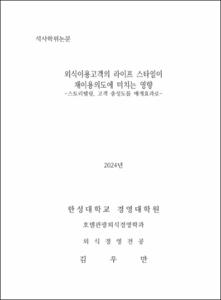외식이용고객의 라이프 스타일이 재이용의도에 미치는 영향
= The impact of restaurant users’ lifestyle on their intention to reuse : Storytelling, customer loyalty as a medium
- Type
- Thesis
- Alternative Title
- 스토리텔링, 고객 충성도를 매개효과로
- Department
- 경영대학원 호텔관광외식경영학과
- Issued Date
- 2024
- Publisher
- 한성대학교 경영대학원
- Appears in Collections:
- 호텔관광외식경영학과 > 1. Thesis
- Files in This Item:
-
-
Download
 200000723178.pdf
기타 데이터 / 1.06 MB / Adobe PDF
200000723178.pdf
기타 데이터 / 1.06 MB / Adobe PDF
-
Items in Repository are protected by copyright, with all rights reserved, unless otherwise indicated.